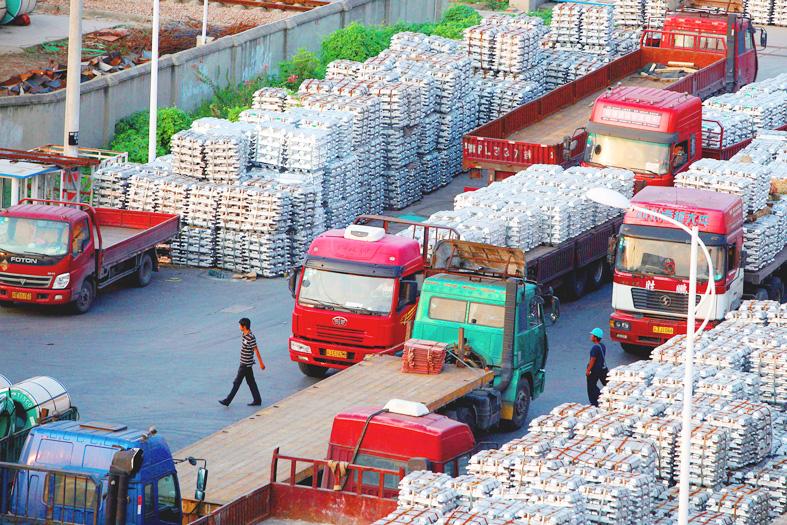Aluminum yesterday rose for a seventh day — to near the highest in a decade — as deepening Chinese output cuts raised fears of a supply shortfall.
The southwestern Chinese province of Guangxi, a major metals producer, would cut output of energy-intensive materials, including aluminum, people familiar with the matter said. That came after the Xinjiang autonomous region started similar curbs last month.
The moves are in response to Beijing’s campaign to save electricity and cut emissions. China produces about 60 percent of the world’s aluminum and the concerns about output prompted some of the country’s largest smelters to hold a video call on Monday in which they pledged to ensure supply, and to avoid malicious speculation and irrational price surges.

Photo: Reuters
Aluminum rose 2 percent to US$2,701.50 a tonne on the London Metal Exchange (LME) as of 12:50pm yesterday in Shanghai. That’s near the intraday peak of US$2,718 in April 2018, which was the highest since May 2011. On a closing basis, the metal is already at the highest in more than 10 years.
Aluminum prices have rallied almost 40 percent this year on the LME, second only to tin among six base metals. Goldman Sachs Group Inc, Citigroup Inc and Trafigura Group are among those forecasting further gains ahead, as the market moves into a deepening deficit just as the global economic recovery gathers steam.
IRON ORE
Separately, iron ore futures retreated as the market weighed a coming seasonal pick-up in Chinese demand against the prospect of a broadly weakening economy and more curbs on steel output.
The raw material had been regaining some ground after a collapse in July, with China’s upcoming fall construction season suggesting higher demand.
However, iron ore still faces headwinds as the world’s largest steel market faces several challenges for the rest of this year. Authorities want to rein in output, and production curbs to reduce emissions are expected to intensify in the last quarter.
Even if seasonal demand is expected to emerge soon, “it’s hard to change the weak outlook for the medium and long-term given the overall guidance to lower crude steel production,” Zhongzhou Futures Co (中州期貨) wrote in a Web site note.
Earlier this week, Baoshan Iron & Steel Co (寶山鋼鐵), the listed unit of China’s biggest producer, flagged the potential for renewed price declines in iron ore.

SEEKING CLARITY: Washington should not adopt measures that create uncertainties for ‘existing semiconductor investments,’ TSMC said referring to its US$165 billion in the US Taiwan Semiconductor Manufacturing Co (TSMC, 台積電) told the US that any future tariffs on Taiwanese semiconductors could reduce demand for chips and derail its pledge to increase its investment in Arizona. “New import restrictions could jeopardize current US leadership in the competitive technology industry and create uncertainties for many committed semiconductor capital projects in the US, including TSMC Arizona’s significant investment plan in Phoenix,” the chipmaker wrote in a letter to the US Department of Commerce. TSMC issued the warning in response to a solicitation for comments by the department on a possible tariff on semiconductor imports by US President Donald Trump’s

The government has launched a three-pronged strategy to attract local and international talent, aiming to position Taiwan as a new global hub following Nvidia Corp’s announcement that it has chosen Taipei as the site of its Taiwan headquarters. Nvidia cofounder and CEO Jensen Huang (黃仁勳) on Monday last week announced during his keynote speech at the Computex trade show in Taipei that the Nvidia Constellation, the company’s planned Taiwan headquarters, would be located in the Beitou-Shilin Technology Park (北投士林科技園區) in Taipei. Huang’s decision to establish a base in Taiwan is “primarily due to Taiwan’s talent pool and its strength in the semiconductor

An earnings report from semiconductor giant and artificial intelligence (AI) bellwether Nvidia Corp takes center stage for Wall Street this week, as stocks hit a speed bump of worries over US federal deficits driving up Treasury yields. US equities pulled back last week after a torrid rally, as investors turned their attention to tax and spending legislation poised to swell the US government’s US$36 trillion in debt. Long-dated US Treasury yields rose amid the fiscal worries, with the 30-year yield topping 5 percent and hitting its highest level since late 2023. Stocks were dealt another blow on Friday when US President Donald

UNCERTAINTY: Investors remain worried that trade negotiations with Washington could go poorly, given Trump’s inconsistency on tariffs in his second term, experts said The consumer confidence index this month fell for a ninth consecutive month to its lowest level in 13 months, as global trade uncertainties and tariff risks cloud Taiwan’s economic outlook, a survey released yesterday by National Central University found. The biggest decline came from the timing for stock investments, which plunged 11.82 points to 26.82, underscoring bleak investor confidence, it said. “Although the TAIEX reclaimed the 21,000-point mark after the US and China agreed to bury the hatchet for 90 days, investors remain worried that the situation would turn sour later,” said Dachrahn Wu (吳大任), director of the university’s Research Center for